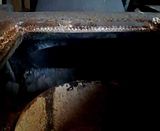new house w/ a FA224
So moved in a few weeks ago in a new house (more like a swiss chalet-looking place) that is using a FA224 as it's main heating source. (there is 2 propane heaters as well throughout the house).
To make a long story short, the landowner came in to "show me the ropes" on the stove. I have small experience with old school wood stoves (i.e. put it in and regulate air flow).
He comes in and notices that the cat is gone... he opens the thing up and I point out that several of the backing plates have disintegrated! (see pics).
Bottom line, he's looking into getting replacement parts.
So this is my stove using a secondary chamber and I'm only on pg.7 of this thread, but figured I'd show some pics and continue reading and informing myself on how to use this stove.
Here is the stove in the main living room
Here is the inside (back plate gone as you can see. Will be replaced soon i hope)
(notice the crack in the back of the stove? It doesn't show on the outside back panel. Should I be concerned?)
Here is a picture of the damper adjuster and it's brass key and the other handle I am curious about. I've added a quick video that hopefully can help identify how they work.

If i am correct, the lever on the left panel is the damper adjuster. As you can see in the video, I have a 2nd small handle that is in the early part of the pipe leaving the stove. That one seems to close off any heat/air to the chimney.
It seems, (please correct me if i'm worng) that I would not touch that small lever. I can play with the damper (closed or open... it doesn't want to stay halfway) as well as the brass dial dampers. Correct?
As soon as the stove is back in working order, I am planning on reading the instructions and trying to follow them to the 't'.
and yes, I'll continue to read through 26 pages before that






























































